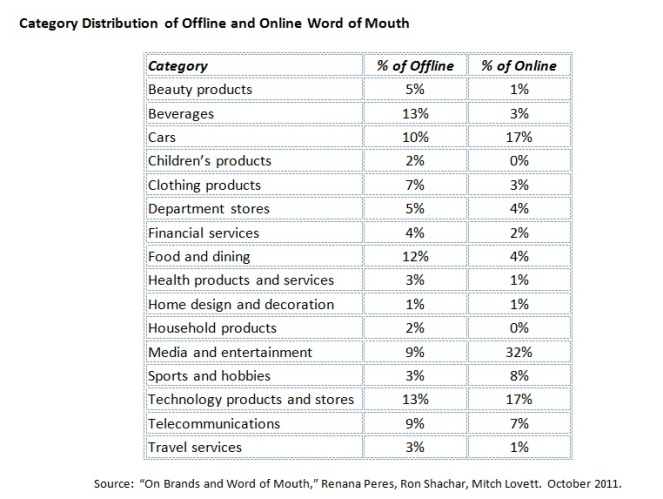Why Brands Must Care about Both Offline and Online Word of Mouth - Ed Keller

I have written previously about a groundbreaking academic study that highlighted how fundamentally different online conversation is from offline word of mouth. The headline finding from that research, released in late 2010 at a conference convened by the Wharton School and the Marketing Science Institute (MSI), was clear: "Online data does not reflect well the offline behavior. Word of mouth is not channel neutral. One cannot automatically generalize the results from online to offline." This is particularly relevant in light of the fact that social media – despite its rapid rise to prominence – still accounts for less than 10% of all word of mouth.
The authors of that research have now released a new working paper that sheds further light on the question of offline versus online word of mouth, and why it matters to brands. In this analysis the focus is on brand characteristics and how those relate to the word of mouth channel consumers choose to deploy.
According to the authors, Professors Renana Peres, Ron Shachar, and Mitch Lovett, "consumers spread the word on brands for three fundamental purposes: functional, social, and emotional. In brief: the functional driver is the motive to provide and supply information; the main social driver is the motive to send social signals to the environment [such as expressing uniqueness, self-enhancement, and a desire to socialize or belong]; and the emotional driver is the motive to share positive or negative feelings about brands in order to express these emotions or balance emotional arousal." Each of these drivers, the authors argue, "is composed of different needs, or motives that play a role in consumer decision making. Each of these motives, in turn, suggests a set of brand characteristics that play a role in stimulating WOM."
The analysis is based on a very large set of data including online word of mouth (provided by NM Incite, the joint venture between Nielsen and McKinsey), offline word of mouth (provided by the Keller Fay Group), brand equity (provided by Brand Asset Valuator), and custom research on brands (conducted by Decipher). Approximately 700 US brands in total were analyzed, spanning 16 product categories, covering the period from 2007 – 2010. So this is a very comprehensive and robust research undertaking.
The primary drivers of online word of mouth, the authors find, are (in order): social, functional, and emotional. The primary drivers of offline word of mouth are the reverse: emotional, functional and social. "Offline conversations, which are mostly in one-on-one settings, are more personal and intimate by nature and thus allow people to share emotions such as excitement and satisfaction. Online WOM, which usually involves 'broadcasting' to many people (e.g. twitter), is more appropriate for social signaling (e.g., uniqueness)."
These results about the motives associated with WOM via different channels may explain why the breakdown of brand categories varies so widely by online versus offline. Media, autos and technology dominate online – all three carrying with them significant social currency in terms of what's new, interesting, and worth sharing with others if your goal is to show that one is "in the know." Meanwhile, numerous other categories are heavily underrepresented in online venues relative to offline. And yet the value of recommendations in those categories, which come primarily offline, is every bit as important and related to business success.

What does this research mean in practical terms? It means that marketers can't choose a "social strategy" without first understanding the motivations of consumers to share. Online social media will be most effective if you have a new product or a new message for which social currency will be gained by sharing. But if you are seeking to tap the emotions that come with strong brand satisfaction and excitement that comes as a result of a recent purchase or exposure to an advertisement, then look for ways to help consumer share those stories offline where they will have their best chance for success.
Offline and online: These are two different channels, requiring different marketing strategies. They are not mirrors of each other, and by no means redundant. Marketers who are searching for the best way to unleash consumer conversation about products, services, and brands, need to take a holistic view and create strategies that are appropriate to the drivers of brand WOM, both those that are expressed online and those that take place offline.
Ed Keller, CEO of the Keller Fay Group, has been called "one of the most recognized names in word of mouth." The publication of Keller's book,The Influentials, has been called the "seminal moment in the development of word of mouth." Ed can be contacted at ekeller@kellerfay.com. You can follow Ed Keller on Twitter: @kellerfay
Read all Ed’s MediaBizBloggers commentaries at WOM Matters.
Check us out on Facebook at MediaBizBloggers.com
Follow our Twitter updates @MediaBizBlogger
The opinions and points of view expressed in this commentary are exclusively the views of the author and do not necessarily represent the views of MediaBizBloggers.com management or associated bloggers. MediaBizBloggers is an open thought leadership platform and readers may share their comments and opinions in response to all commentaries.


